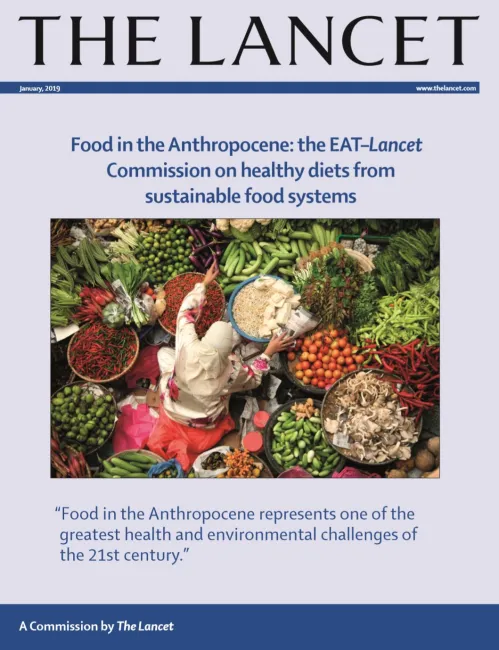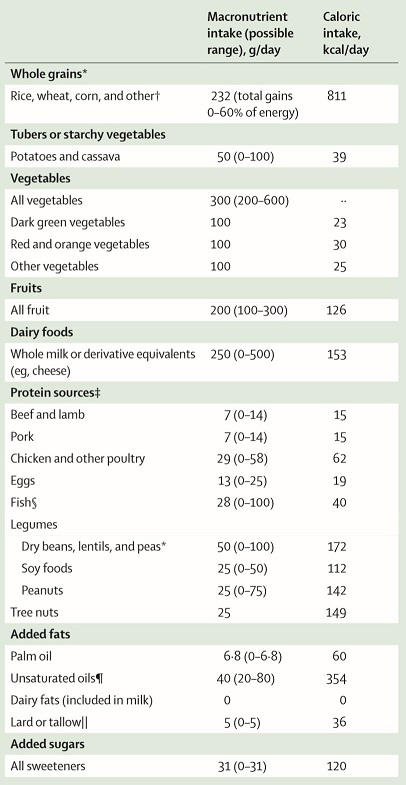The EAT-Lancet Commission sets out a “universal healthy reference diet” that it argues will allow the food system to remain within the planetary boundaries while feeding 10 billion people by 2050. The suggested diet includes a variety of plant-based foods and low amounts of animal-based foods.

The reference diet is set out in the table below. The authors point out that it can be adapted for different cultures and preferences. Compared to current consumption patterns, shifting to the reference diet would require a substantial reduction in meat and sugar consumption, and a doubling of nut, fruit, vegetable and legume consumption


Image: Table 1, EAT-Lancet Commission. Healthy reference diet, with possible ranges, for an intake of 2500 kcal/day. For an individual, an optimal energy intake to maintain a healthy weight will depend on body size and level of physical activity. Processing of foods such as partial hydrogenation of oils, refining of grains, and addition of salt and preservatives can substantially affect health but is not addressed in this table. *Wheat, rice, dry beans, and lentils are dry, raw. †Mix and amount of grains can vary to maintain isocaloric intake. ‡Beef and lamb are exchangeable with pork and vice versa. Chicken and other poultry is exchangeable with eggs, fish, or plant protein sources. Legumes, peanuts, tree nuts, seeds, and soy are interchangeable. §Seafood consist of fish and shellfish (eg, mussels and shrimps) and originate from both capture and from farming. Although seafood is a highly diverse group that contains both animals and plants, the focus of this report is solely on animals. ¶Unsaturated oils are 20% each of olive, soybean, rapeseed, sunflower, and peanut oil. ||Some lard or tallow are optional in instances when pigs or cattle are consumed.
The report finds “with a high level of certainty that global adoption of the reference dietary pattern would provide major health benefits, including a large reduction in total mortality.” Specifically, changing from current diets to the reference diet could avert around 11 million deaths per year.
The report the assesses current and potential performance of food systems with respect to climate change, biodiversity loss, freshwater use, interference with the global nitrogen and phosphorus cycles, and land-system change. Chemical pollution was not assessed.
In addition to dietary change, the report calls for improved food production (including more efficient use of fertilisers and water, reduction of yield gaps, zero expansion of agricultural land onto natural ecosystems and forests, land management practices that shift agriculture from a carbon source to a carbon sink) and reduced food waste.
The report makes the following recommendations for action:
- Seek international and national commitment to shift towards healthy diets
- Reorient agricultural priorities from producing large quantities of food to producing healthy food
- Sustainably intensify food production, generating high-quality output
- Strong and coordinated governance of land and oceans
- At least halve food loss and waste, in line with global Sustainable Development Goals
Read the full report, Food in the Anthropocene: the EAT-Lancet Commission on healthy diets from sustainable food systems, here. See also the Foodsource chapter What is a healthy sustainable eating pattern?




Comments (0)